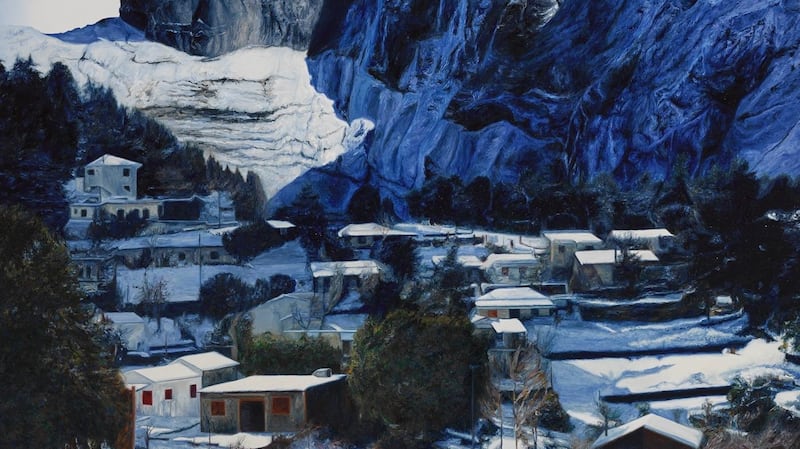Louise Neiland: Calibration
★★★★
Taylor Galleries, Dublin
Louise Neiland's 2013 exhibition at the Taylor was entitled Landfall – as in the moment when a storm moving across the sea makes landfall. That uneasy, suspended moment of anticipation seems to engage her, as the atmosphere is about to flip from one state to another. Her landscapes are often overseen by sullen skies, charged with hushed expectation, coloured by an unsettling light. You can almost feel the crackle of static. Equally, the multiple moons, the luminous pale discs that recur in her paintings, whether singly or arrayed in orderly grid patterns, evoke not transformative instants but the lunar cycle and the measure of time, regular and dependable. Constancy and change: it is an elemental and metaphorically rich combination and Neiland has been making paintings that explore variations on it from the early years of the century.
In Calibration she refers to "the process of measuring the relationship between two quantities". Calibration depends on a known, reliable scale against which an unknown can be calculated. So those two related concerns continue to run through the paintings: unpredictable events and the application of standard units of measurement. As glimpsed from picture to picture, the events include fire, storm, whirlwind and flood. Aircraft appear recurrently, and they have the appearance of reconnaissance planes, skirting the edges of storm clouds, surveying. More abstractly, other intimations of measurement intrude into the representational images.
Lest that sound very dry and remote, there is, it should be said, another layer to the world that Neiland evokes. It is not quite a nowhere, but her landscapes are pared back and stylised, and hard to pin down. A bit like the American Midwest – vast plains where storms brew – they can on other occasions appear tropical and coastal, with what look like stilt houses perched on piles to keep them above the flood-line. Climate change comes to mind, and there is a pervasive sense of living in precarious environmental conditions, so it is certainly relevant, but it’s fair to say that her work does not come across as being about climate change per se, it is a more general statement on the human condition.
In relation to which, it is as if she constructs a fictional space, one she populates with just a few people, like characters in a story. Not that she particularly pursues a linear narrative either. There are hints but they are left hanging, though they do contribute greatly to the atmosphere.
One small composition, Furious Days, which features two figures, an adult and a child, standing by and on a geometric construction, perhaps a kind of mini-ziggurat, is particularly compelling and brings to mind the magical work of the tragically short-lived Japanese artist Toshio Arimoto. While still young – he was only 38 when he died – he visited Europe, and seeing the art of the early Italian Renaissance painters changed his life, providing him with an allegorical dream world in which his subjects lived, for ever after.
Neiland's dream world has a different grounding, and a different mood, but it is as quietly persuasive and, on occasion, compelling. Technically the work is crisply well made. She is equally comfortable with intimate, small-scale images and epic, three metre-plus compositions that reinforce the sense of vastness that is essential to her aims. Each of the four major rooms of the Taylor features one of these very large works. They are painted on paper and float free against the wall in what is overall a very effective installation. A museum-scale show, it is, apart from anything else, a great showcase for the potential of the gallery's handsome spaces. Until March 10th, taylorgalleries.ie
Paul McKinley: Elysian Fields
★★★★
Kevin Kavanagh Gallery, Dublin
Paul McKinley's Elysian Fields amounts to a portrait of a Greece of the imagination. Hence the reference to the domain of the mythological afterlife, inhabited by "the souls of gods and heroes". He has also made one very fine painting of an associated perennial, the asphodel. But more to the point he equally has in mind Greece in the 21st century, a site of economic woe and, at the same time, an hospitable staging post for desperate refugees and migrants. The landscape becomes a vehicle for exploring what is beyond the immediately visible and familiar.

McKinley defers to the contemporary voyagers as symbolic descendents of the mythic figures of classic antiquity in shaping his vision. His paintings, constituted in fluid streams of oil pigment, depict apparently solid features – such as jagged headlands verdant and in one case snowy uplands – but always, by virtue of that flowing pigment, in a state of flux and curiously malleable. And they are composites of different views, not just edited together but also exaggerated and altered at will.
Born in Birmingham, McKinley has long been based in Ireland and has made his artistic career in the country. Beginning with views of urban parklands, he has through many series of paintings explored ideas of the recreational landscape, moving on from the park to more troubling locations that have darker associations.
As regards this current body of work he was, presumably, struck by news accounts of a surreal dissociation in the Mediterranean, when tourists at play and desperate refugees at the end of their tether – some of them dying – found themselves in the same space.
His linking vision subtly incorporates these circumstances and more, including the saving grace of Greeks who, while themselves in dire straits, reached out to help. Until March 10th, kevinkavanaghgallery.ie









